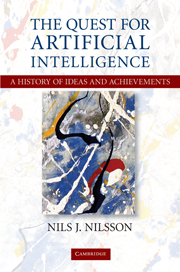Book contents
- Frontmatter
- Contents
- Preface
- PART I BEGINNINGS
- PART II EARLY EXPLORATIONS: 1950S AND 1960S
- PART III EFFLORESCENCE: MID-1960S TO MID-1970S
- PART IV APPLICATIONS AND SPECIALIZATIONS: 1970s TO EARLY 1980s
- PART V “NEW-GENERATION” PROJECT
- PART VI ENTR'ACTE
- PART VII THE GROWING ARMAMENTARIUM: FROM THE 1980s ONWARD
- 26 Reasoning and Representation
- 27 Other Approaches to Reasoning and Representation
- 28 Bayesian Networks
- 29 Machine Learning
- 30 Natural Languages and Natural Scenes
- 31 Intelligent System Architectures
- PART VIII MODERN AI: TODAY AND TOMORROW
- Index
- Plate section
29 - Machine Learning
Published online by Cambridge University Press: 05 August 2013
- Frontmatter
- Contents
- Preface
- PART I BEGINNINGS
- PART II EARLY EXPLORATIONS: 1950S AND 1960S
- PART III EFFLORESCENCE: MID-1960S TO MID-1970S
- PART IV APPLICATIONS AND SPECIALIZATIONS: 1970s TO EARLY 1980s
- PART V “NEW-GENERATION” PROJECT
- PART VI ENTR'ACTE
- PART VII THE GROWING ARMAMENTARIUM: FROM THE 1980s ONWARD
- 26 Reasoning and Representation
- 27 Other Approaches to Reasoning and Representation
- 28 Bayesian Networks
- 29 Machine Learning
- 30 Natural Languages and Natural Scenes
- 31 Intelligent System Architectures
- PART VIII MODERN AI: TODAY AND TOMORROW
- Index
- Plate section
Summary
Automated data-gathering techniques, together with inexpensive mass memory storage apparatus, have allowed the acquisition and retention of prodigious amounts of data. Point-of-sale customer purchases, temperature and pressure readings (along with other weather data), news feeds, financial transactions of all sorts, Web pages, and Web interaction records are just a few of numerous examples. But the great volume of raw data calls for efficient “data-mining” techniques for classifying, quantifying, and extracting useful information. Machine learning methods are playing an increasingly important role in data analysis because they can deal with massive amounts of data. In fact, the more data the better.
Most machine learning methods construct hypotheses from data. So (to use a classic example), if a large set of data contains several instances of swans being white and no instances of swans being of other colors, then a machine learning algorithm might make the inference that “all swans are white.” Such an inference is “inductive” rather than “deductive.” Deductive inferences follow necessarily and logically from their premisses, whereas inductive ones are hypotheses, which are always subject to falsification by additional data. (There may still be an undiscovered island of black swans.) Still, inductive inferences, based on large amounts of data, are extremely useful. Indeed, science itself is based on inductive inferences.
Information
- Type
- Chapter
- Information
- The Quest for Artificial Intelligence , pp. 398 - 430Publisher: Cambridge University PressPrint publication year: 2009
Accessibility standard: Unknown
Why this information is here
This section outlines the accessibility features of this content - including support for screen readers, full keyboard navigation and high-contrast display options. This may not be relevant for you.Accessibility Information
- 4
- Cited by
